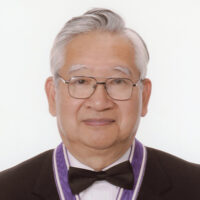
2007 Kyoto Prize Laureates
Earth and Planetary Sciences, Astronomy and Astrophysics
/ Geophysicist
1936 -
Professor Emeritus, California Institute of Technology
2007
11 /11 Sun
Place:Kyoto International Conference Center
From Great Earthquake Seismology to Real Time Seismology
2007
11 /12 Mon
13:00 - 17:30
Place:Kyoto International Conference Center
Dr. Hiroo Kanamori has made an epoch-making progress on the study of great earthquakes through the establishment of analytical method to understand quantitatively all over the rupture process of a great earthquake making full use of seismogram. This study has ushered in a new era in seismology and had a significant impact on the development of geophysics. He has made practical proposals on how to mitigate earthquake hazards based on the knowledge gained through basic studies and contributed to building up and conducting earthquake hazard mitigation systems.
Dr. Hiroo Kanamori has made an epoch-making progress on the study of great earthquakes by establishing analytical method to understand quantitatively all over the process of a great earthquake making full use of seismogram. This study has ushered in a new era in seismology and had a significant impact on the development of earth sciences. He has made practical proposals on how to mitigate earthquake hazards based on the knowledge gained through basic studies and contributed to building up and conducting earthquake hazard mitigation systems.
In the 1960s, Dr. Kanamori began investigating great earthquakes and sequentially revealed the essential mechanism of rupture at great earthquakes occurred along the Pacific Rim. These allowed him to establish almost single-handedly a field that may be called “great earthquake seismology.” With his continued study, Dr. Kanamori contributed to development of the newly-born plate tectonics theory and introduced the “moment magnitude” as a new measure of earthquake magnitude. Its usefulness is clearly demonstrated by the fact that most seismological institutions used only this magnitude when reporting the Sumatra-Andaman earthquake of December 2004.
With the advance of observation and computation technologies, Dr. Kanamori extended his studies on great earthquakes. He proposed the “asperity model” providing a general explanation of the diversity of the rupture process. The validity of this model is currently being demonstrated by a global positioning system network that detects aseismic slip events around asperities. He applied “great earthquake seismology” to the elucidation of diverse seismic phenomenon. This work has continued to have a significant impact on various fields of earth science. Moreover, he applied research findings on the rupture process to seismic hazard mitigation, including proposal of a tsunami warning system based on real-time analysis of long-period seismic waves, adverting to dangerousness in resonance of huge structures, e.g., high-rise buildings and oil storage tanks, with long-period seismic waves, and advocating the usefulness of “real-time seismology.” A practical system of real-time seismology has already begun operating in Southern California. It acquires and analyzes data immediately after the occurrence of a major earthquake and uses them to predict strong motions just before the arrival of seismic waves. This approach is also being adopted in Japan and other countries. Dr. Kanamori’s proposals for mitigating seismic hazards are just coming to fruition.
Dr. Kanamori has been a major influence on various fields of earth sciences by creating a modern seismology and by demonstrating the diversity of earthquake phenomenon. Not content with these achievements, he has also made a substantial contribution to human well-being through his work to mitigate seismic hazards.
For these reasons, the Inamori Foundation is pleased to present the 2007 Kyoto Prize in Basic Sciences to Dr. Hiroo Kanamori.
Profile is at the time of the award.